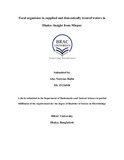Fecal organisms in supplied and domestically treated waters in Dhaka: insight from Mirpur

View/
Date
2019Publisher
BRAC UniversityAuthor
Rafin, Abu NowrozeMetadata
Show full item recordAbstract
Dhaka, the capital city of Bangladesh, has become a megacity with a population of nearly 12.5 million, which is increasing at an annual rate of over 5% (Haq, 2006).So, it is always a challenge to meet the ever increasing demand for pure drinking water of this huge population. This study aims to detect the presence of Escherichia coli which is a fecal coliform and also an another water borne disease causing organism which is Salmonella spp. Altogether,139 samples were collected from Mirpur (section-1,2,10 and 11) starting from October 2018 to April 2019.The water samples were tested . The supplied water samples collected from these four zones produced variable fecal coliform (FC) counts (cfu/100mL); 13.46% in FC count 0, 15.38% in FC count 1-5, 51.92% in FC count 6-30,19.23% in FC count 30-100 and 0% in FC count <100 from October to the beginning of February. The results also displayed overall increase in FC count during February to March month of the year which is considered as wet season which was likely to happen. Then considering the processed water which includes boil water and filter water, the results showed 65.38% in FC count 0. Then, in the detection of Salmonella spp, PCR had been used and bands were observed for 13 samples from the raw water samples where 5 samples came from the slums of Mirpur and korail which water samples were also detected with fecal coliform count>300 in previous procedure. This study shows the presence of E.coli and Salmonella spp in the raw water of Mirpur area and as a result people who are living in the slum are in greatest danger as they do not boil or filter their water prior to drink.
